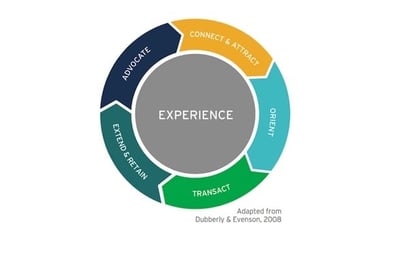For those of us who have a front row seat to the digital transformation of the customer experience in life insurance, there is a sense that our world is being, or about to be, rocked.
In a way, it is; however, when you understand the customer experience cycle and all its component phases, you realize that the job of attracting new customers is, at its heart, fundamentally the same, but now there are more options for doing so.
The experience cycle, a model developed by Dubberly & Evenson, 2008, is a great framework for understanding the phases that turn a prospect into a customer and a customer into a raving fan of your brand. While life insurance customers are seldom characterized as raving fans, there’s no reason the industry shouldn’t continue to strive for ways to achieve that.
If we are to create raving fans, we must consider all the phases of the customer experience deeply. Then we must do our jobs right at each phase, understanding what drives satisfaction and behavior, what turns people off, and what touchpoints are most important or provide missed opportunities.
(Related: Who Controls Your Customer Experience?)
Prior to the digital age, it was hard to do this in any setting other than in person or face to face with an agent. Now, if we are to recognize the omnichannel expectations, we need to ensure we are covering all of these bases in whatever channel we are using. And if we are using multiple channels, we had better be saying and conveying the same thing, because gaps or inconsistencies create mistrust.
For example, if your website offers a needs assessment or a wellness scoring system, your agent channel should be well versed in it too. Imagine someone engaging with your online tools, getting a result, and then switching to your agent channel for advice about it. Then imagine the agent doesn’t know about the tool, doesn’t understand it or, worse, chooses to dismiss it. How would it make that potential customer feel about your company?
Yikes.
So a good starting point to avoiding that nightmare and others is to understand the phases of the customer experience cycle and make sure all channels are aligned similarly around the experience you want to create.
A webinar about Dubberly & Evenson experience model, produced in partnership with LexisNexis Risk Solutions, is available here.
Here are the phases in the model, and what we should seek to achieve at each phase:









 June 08, 2018 at 08:06 PM
June 08, 2018 at 08:06 PM












